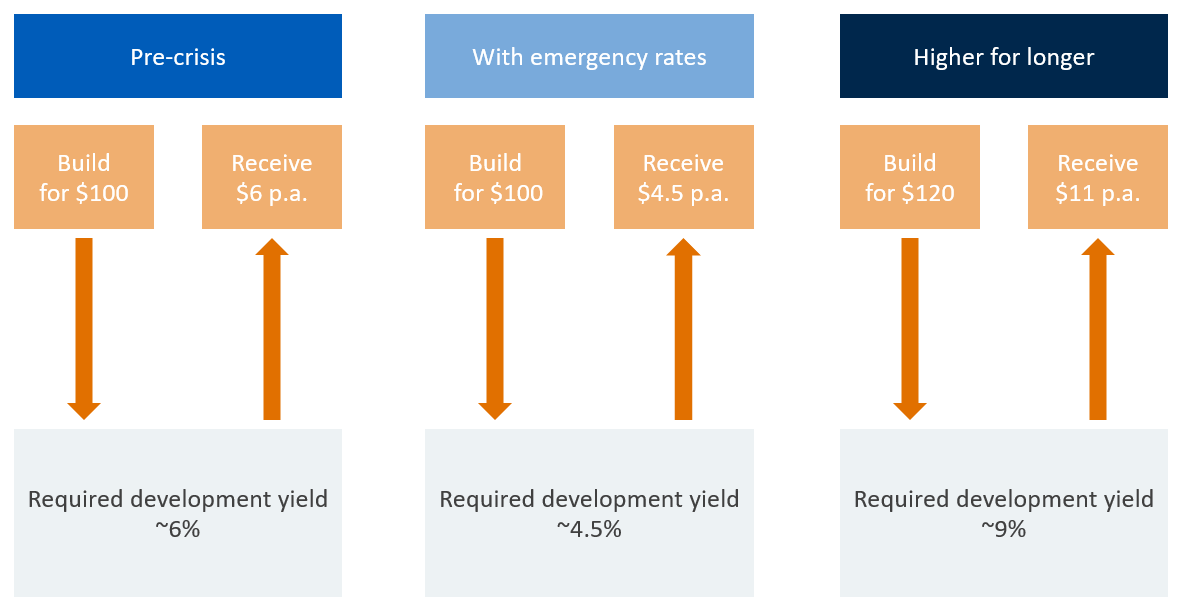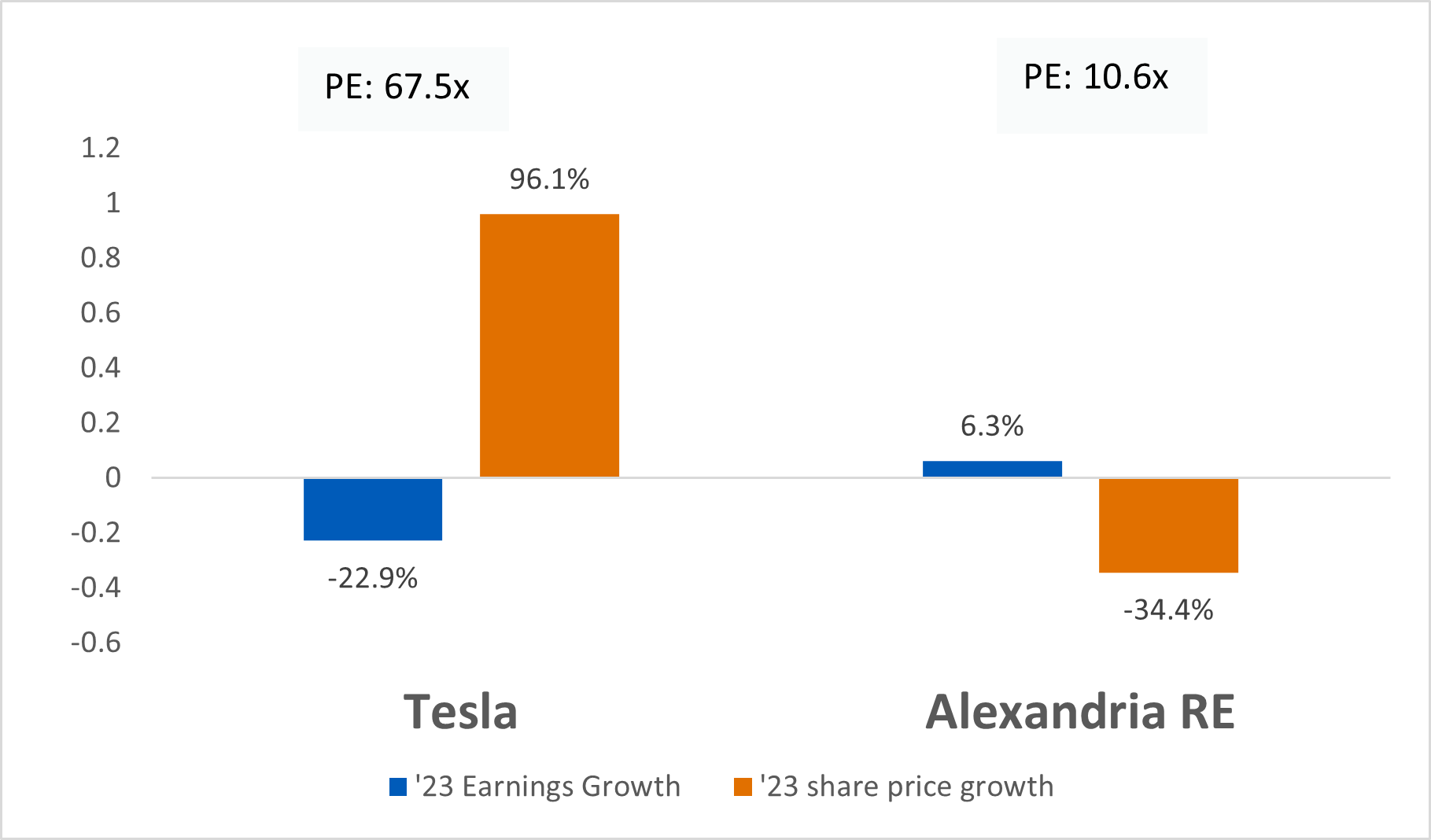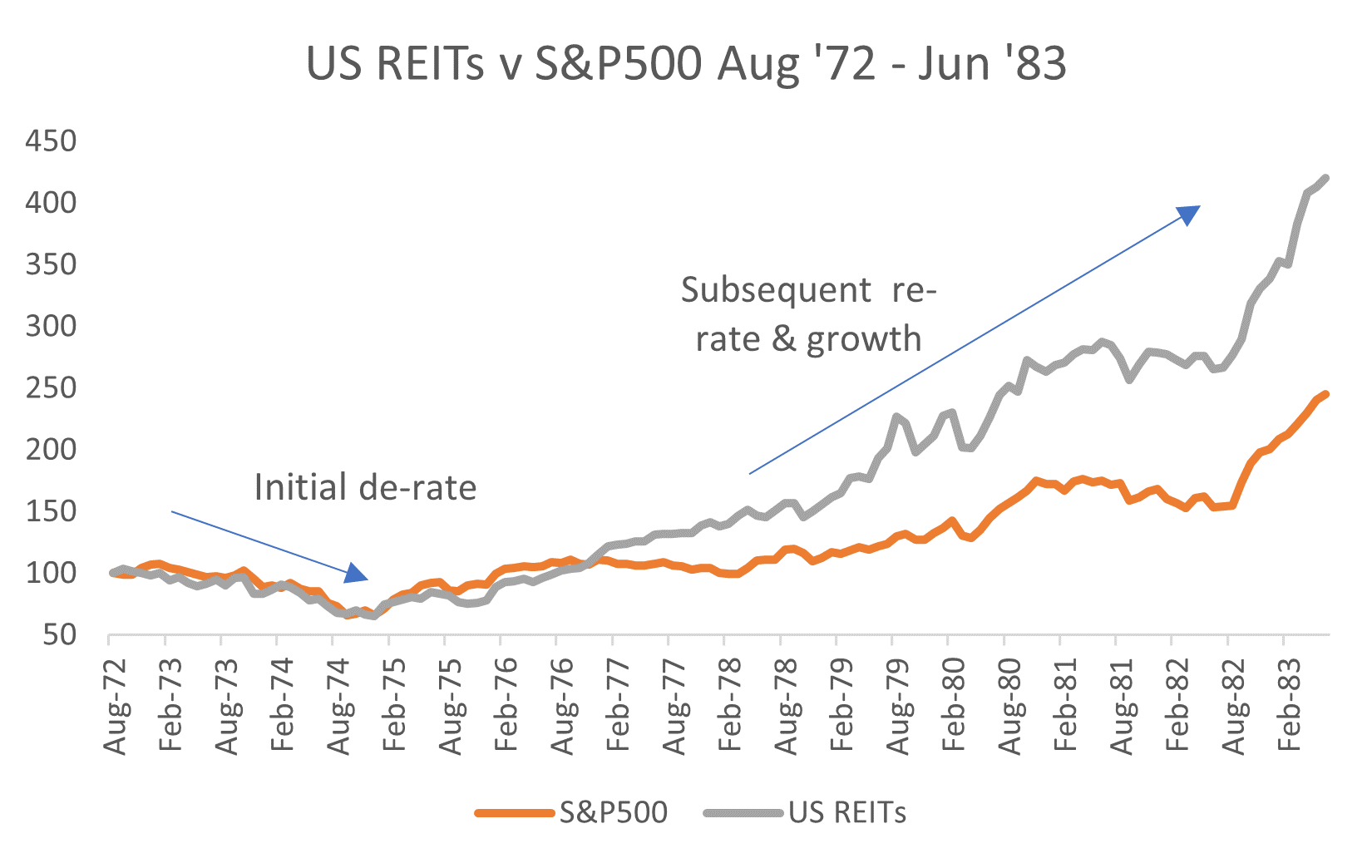The capitulation of the long end of the yield curve has been brutal. In the US, for the best part of 18 months, the inverted yield curve (defined as long end interest rates lower than the short end) has predicted a recession. This has been supported with several credible forecasters assigning up to +90% probability that a US recession would occur this year[1].
However, the relentless wave of good economic news, culminating with a stunning c5% GDP growth for the September quarter has resulted in the recession bets being taken off the table.
As investors unwind their rate cut expectations, long-term interest rates have risen globally (especially in the US). The inverted yield curve – the harbinger of a recession, is all but gone. It seems most market participants are now expecting and pricing an interest rate environment that is ‘higher for longer’. If this is the case, what will it mean for real estate?
What drives real estate pricing cycles?
Before we assess the impact of a sustained higher interest rate environment, we first must turn to a framework that describes real estate pricing cycles.
Most commentators tend to believe real estate pricing cycles depend on interest rates. Yet, the fact that Australian and US residential property has been rising this year suggests this idea is too simplistic.
At Quay, our framework is based on a simple, but we believe, powerful idea – that most forms of real estate are priced around replacement cost over time. That is, when the pricing of a particular type of real estate is below the cost of the build, then new supply will become constrained. Conversely, when prices are elevated and above the cost to build, the development margin attracts capital, creating new supply until the profit margin is no longer attractive.
We believe the logic of this idea is both simple and clear. Moreover, it’s an idea that holds despite the interest rate environment, or whether we experience a high or low inflationary environment as the chart below depicts.

Source: Quay Global Investors
Getting to replacement cost the easy way
For the best part of 40 years, central banks have cut interest rates in response to major economic events. Whether it was the Asian Financial Crisis (1997), the US ‘Tech Wreck’ (2001), the Global Financial Crisis (2008) or the pandemic (2020), the ‘go-to’ policy response from central bankers was to reduce interest rates.
As we wrote and predicted in our 2015 article, "A case for Australian interest rates to approach 0%", new credit creation is encouraged each time interest rates are reduced. This increases the stock of private debt, requiring an even greater cut for the next crisis.
There were implications for real estate too. As central banks cut interest rates, real estate capitalization rates also fell, pushing capital values higher for the same dollar of rent. Ultimately, values would rise above building and land costs, and a new development cycle would occur.
As this has been the economic model for over 40 years, it has now become accepted wisdom that real estate is just a simple interest rate play. But in a higher-for-longer world, that perception is likely to change.
Getting to replacement cost the hard way
One of the overriding themes we hear today from our investees is that it’s becoming harder to make new development ‘pencil’. Whether it be in residential, shopping centers, data centers, senior housing or self-storage, the metrics needed to justify new capital spend have changed, radically.
Using the replacement cost framework, this comes as no surprise. Not only has the cost to build increased, the cost of (and access to) capital has also increased, significantly. For example, prior to the pandemic, developers would require, say, $6 of rent per annum for each $100 of capital invested. That may have dropped to $4.50 in a zero interest rate environment as funding became cheaper and more accessible.
However, in today’s environment, risk capital now requires a much higher return, and therefore, level of rent per dollar of capital before new supply is feasible. After adjusting for higher inflationary building costs AND higher required return on capital, in some cases, rents may need to more than double from current levels before new supply is encouraged.

Source: Quay Global Investors
The bad news, and the good news
Although the supply spigot has now largely been turned off, it still can take years for demand-supply disequilibrium in the leasing market to push rents to high-enough levels to begin a new building cycle - especially compared to the ‘sugar hit’ pricing adjustments which came from successively lower interest rates. Given the sector has been (wrongly) tagged as an interest rate sensitive sector, the industry is now undergoing a painful adjustment period where it’s priced purely on a yield basis, despite decent near-term growth, and soon-to-be significant long-term growth. This means near-term losses.
An example of this dynamic is highlighted below. The perceived high growth security (Telsa) will have meaningfully lower earnings this year, yet the share price is up +96% due to long-term growth expectations. Meanwhile, Alexandria Real Estate Equities, a US REIT focused on life science properties will post +6% earnings growth, and yet the stock has lost a third of its value. To us, the pricing disconnect is now quite extreme.

Source: FactSet, Quay Global Investors
And therein lies (some) of the good news for the sector. That is, the pain is likely to have already been largely priced in.
Equity investors have adjudicated that the real estate sector is a low growth, yield sensitive sector and it has been priced accordingly. Why own real estate on a dividend yield of 4-5% when you can get that or more from term deposits?
We have been here before
While this may sound wildly optimistic, history is on our side. This adjustment phase has happened before. Following the relatively benign interest rate setting of the 1960’s, the surge in inflation and building costs negatively impacted the price of equities and real estate. However, after several years of ever-rising costs of construction, in conjunction with steady tenant demand, tenants were squeezed. This first pushed rents, then real estate, prices upwards, leading to significant outperformance - especially relative to equities, as the following chart demonstrates.

Source: Case Shiller, Bloomberg, NAREIT, Quay Global Investors
But forget the 70’s … in some cases, it’s happening now
Real estate as a growth sector?
After 40 years of being pigeonholed as a ‘yield play’, this may be hard to contemplate. But is it really that hard to accept? In the residential markets of Sydney and Melbourne, we have already seen sustained multiple year double-digit rental growth as incremental demand scrambles to find accommodation in supply-constrained markets.

Source: SQM research, ABS, Quay Global Investors
And beyond the residential market, prior to the pandemic, the supply-demand mismatch in the leasing market for industrial property resulted in multiple years to double digit market rent growth.
Concluding thoughts
At Quay, we believe to understand real estate pricing cycles, one must also understand the interplay between the primary market (developers and builders) and the secondary market (the pricing of stabilized real estate). If interest rates are to be higher for longer, then the old model of building a piece of real estate for $100 to only return $5 in rent, are over. And this has implications for real estate pricing.
Today, market prices are sending a signal to developers and capital providers to stop construction. This, in turn, has been helped by central bank policies that has made funding more difficult and expensive to obtain.
However, where population growth incrementally adds to tenant demand, new construction will be required in the future. For example, in countries like Australia, where the population is growing at 1-2% per annum, in five years we will have 5-10% more people. This means our built environment needs to be 5-10% larger than what it is today – across all forms of real estate. The fact the opposite is now occurring will lead to a significant rental squeeze that will eventually flow to rents and asset prices. This is getting to replacement cost the hard way – the hard part will be for the tenants. But it will be necessary to kick-off the required development cycle.
If we truly are in a higher for longer environment, the Australian residential rental market will be just the beginning of a global rental squeeze.
[1] https://www.conference-board.org/publications/CoW-Recession-Probability
The content contained in this article represents the opinions of the authors. The authors may hold either long or short positions in securities of various companies discussed in the article. This commentary in no way constitutes a solicitation of business or investment advice. It is intended solely as an avenue for the authors to express their personal views on investing and for the entertainment of the reader.
